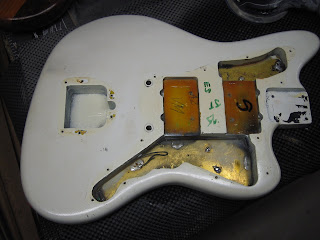<
A fairly straightforward project here - a 1966 Fender Jazzmaster body that had been poorly refinished over the years and that the owner wanted to do in an aged Olympic White finish.
The original Olympic White is a color thats seldom seen - its a bright white color that has a slightly bluish and very very slight grey tint to it - which makes it look like a fairly harsh white. However, the vast majority of Olympic White Fenders had a nitro clearcoat, or in later years were sprayed in a polyurethane finish - both of which aged the Olympic White to a buttery yellowish color.
The only truly Olympic White instrument I've seen in person was an early Jazzmaster - probably from 1960- 62, which hadn't been given a clear topcoat, and was therefore still a brilliant white color. And yes I remember my buddy Rod selling it at a guitar show for $800 ... which was a decent price back then .. I'm not sure you can even get a Japanese reissue for that price these days !!!
So this project came to me with a worn flat white finish - which was over the remnants of a black finish - which actually looked like black automotive primer. The guitar obviously had been sunburst originally, but had been stripped before getting its "excellent" refinish. Note the "S" scrawled in the neck pickup cavity for "sunburst" - and the "ES" stamp under the finish between the pickup routes. My post on a
1966 Mustang explains the meaning of the ES stamp.


Fortunately, the finish sanded off very easily and fairly cleanly. I did notice that the grain of the alder body was visible through the poorly done refinish - probably meaning that body had been stripped with steel wool at some point, which has the effect of revealing the grain, since the softer parts of the wood get worn away by the steel wool. Meant the body would require a good sealing and maybe a few primer coats to get a smooth finish.

The body did come out fairly clean - clean enough that redoing the original sunburst would have been an option, but the owner was set on Olympic White. Notice the remnants of the original yellow stain on the back of the body.


Re-dying the body yellow was the first step - followed by several applications of Behlen's clear vinyl sealer, which is very similar to the Fullerplast vinyl sealer that was used by Fender.

After a light sanding, a coat of white nitro primer was applied. The grain was still visible at this stage, so after wetsanding a second primer coat was applied and wet sanded. This appeared to completely fill and level the rear surface of the body, making it ready for the gloss white color coat.
The color coat went on smoothly, since the body had been extensively prepped by this time. Two color coats were applied - with a light sanding inbetween to smooth out any overspray.

I wanted to keep the overall finish as thin as possible, but this was going to be a challenge since I'd already applied two primer coats and the tinting of the overcoat would require at least 4 or 5 clear coats - so as soon as the color coat looked good, I applied a thin clear coat to seal it in and protect it.
I then got the tinted clear coat ready - which I wanted to do in as few passes as possible but still have an even tinting. I decided to use a tinting mix that I had used the day before on a
68 Telecaster refinish - but to cut it slightly with more clear lacquer and a little more acetone (as thinner) than usual.
I sprayed a test patch on a piece of white masonite and set my spray gun for a fairly wide pattern, at a low pressure, with a moderately heavy coat but more thinned than usual lacquer.
As I started spraying - I resisted the impulse to try to build up color quickly, instead building up evenly over several passes. The color came out very even and had exactly the look I wanted - not as yellowed as some 60s Fenders I'd seen, but a nice subtle buttery color.

Two further coats of clear nitro were then applied, to lock in the ambered clear coat. After these had dried for roughly a week and a half, I carefully wet sanded and then buffed out the body - to result in what looks like an aged Olympic White finish.


Once the owner re-assembles the guitar, I will post pictures of the complete instrument.

























3 comments: